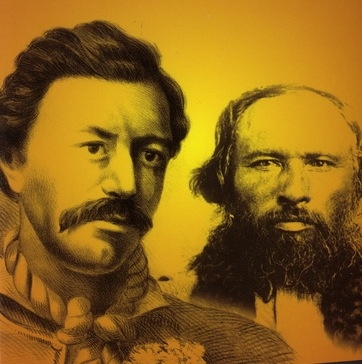
Louis Riel and Gabriel Dumont
By Joseph Boyden • Penguin, 2010, pp.204
After a night spent alone in mid-May 1885, Louis Riel emerged from the wilderness and surrendered to Canadian military. He was the leader of the Métis rebellion that the government of Sir John A. McDonald was intent on crushing. Riel hoped that voluntarily turning himself over would garner him some goodwill on the part of the authorities. It soon became clear that none would be forthcoming. Following months in captivity he was charged with high treason. The trial was held in Regina even though Riel has asked that it be held closer to home. The judge assigned to the trial was no judge at all, but rather a stipendiary magistrate who has formerly publicly denounced the Métis leader. Instead of 12 jury members, only 6 were picked for this trial and all were white, Protestant males from Ontario, where the Métis had no respect and even less sympathy. Finally, Riel’s defence only had a few days to prepare. The trial’s outcome was thus hardly surprising. Riel is found guilty of high treason and given the death penalty. On November 16, 1885 Riel was hanged.
The fate of Louis Riel is known by most Canadians. Less appreciated is the role of Gabriel Dumont in Riel’s return to Canada from exile and the Métis rebellion that soon followed. In his book Louis Riel and Gabriel Dumont, the Canadian novelist Joseph Boyden explores these aspects of Riel’s story. In the mid to late 19th century, Canada’s buffalo population was being driven to near extinction. The Métis were thus forced to become subsistence farmers. But the land they were living on for generations was fertile and thus valuable. The federal government would routinely send surveyors west to capture more and more land. Like the rest of the Indian populations, the Métis were regarded as a nuisance to be subdued and certainly not as a people worthy of respect or equality. The Métis, of course, would not prove so easy to efface. Gabriel Dumont was among the Métis leaders. He was strong as a bull, a skilled fighter and fiercely committed to protecting his community from the growing threat from the east. But he realized if the Métis were to successfully defend themselves they would require the presence of their spiritual leader, Louis Riel. And so early one morning in early June 1884, Dumont rode south to Montana, where he found Riel living a quiet life. After careful deliberation, Riel agrees to return from exile.
As Boyden describes, Riel’s role in the Métis rebellion is complicated and contradictory. He was their spiritual leader and thus inspired devotion among his fellow Métis. He believed the path to peace and reconciliation with the government was through non-violence. The Métis demands were, after all, reasonable and fair. They wanted right to the land that they had living on for years. They wanted respect for their culture and they wanted to avoid the conditions of dire poverty that were already starting to afflict native Canadians everywhere around them. Surely, Riel thought, the government would at least acknowledge the legitimacy of their grievances and demands. Surely they would want to avoid bloodshed. Almost up until the day he surrendered, Riel clung to these hopes.
Such expectations were misguided but not necessarily unreasonable. The problem was that Riel was, at the very least, delusional. He believed he was a prophet of a new world and that God spoke to him directly. His delusions compromised his military judgment, but not the support of his community. Dumont is thus torn by the combination of Riel’s exulted status and the questionable direction in which he pushed the rebellion. Should Dumont share in Riel’s faith in God and in the government, despite all the evidence that contradicted both? Should the Métis avoid engaging in military battles with Canadian military forces? Dumont was a brave man, a warrior. His instinct was to fight. He knew better than Riel than to trust the government to negotiate in good faith, or to trust that the military would not ruthlessly crush the rebellion given the chance. But he also believed Riel possessed greater spiritual gifts than he and that Riel’s faith might ultimately prove decisive. Perhaps the Métis were on the verge of establishing a ‘new world.’ Their opposing instincts lead to crucial bouts of indecisiveness on the part of the rebellion. Eventually the Métis were defeated.
Boyden’s first priority in writing this book is to simply tell the story well of these two great men and the rebellion they led. He brings his considerable skills as a novelist to bear on the task. He brilliantly creates a sense of tension and foreboding from the first page onward. The sense that the Métis and the Canadian military are on a collision course is palpable. But Boyden’s aim is also to make the reader reflect on the broader themes of injustice, violence and cultural intolerance the lives of Dumont and Riel touch on. As Boyden reminds the reader, the fate of the two men and the community they led raises questions still relevant in the world today.










